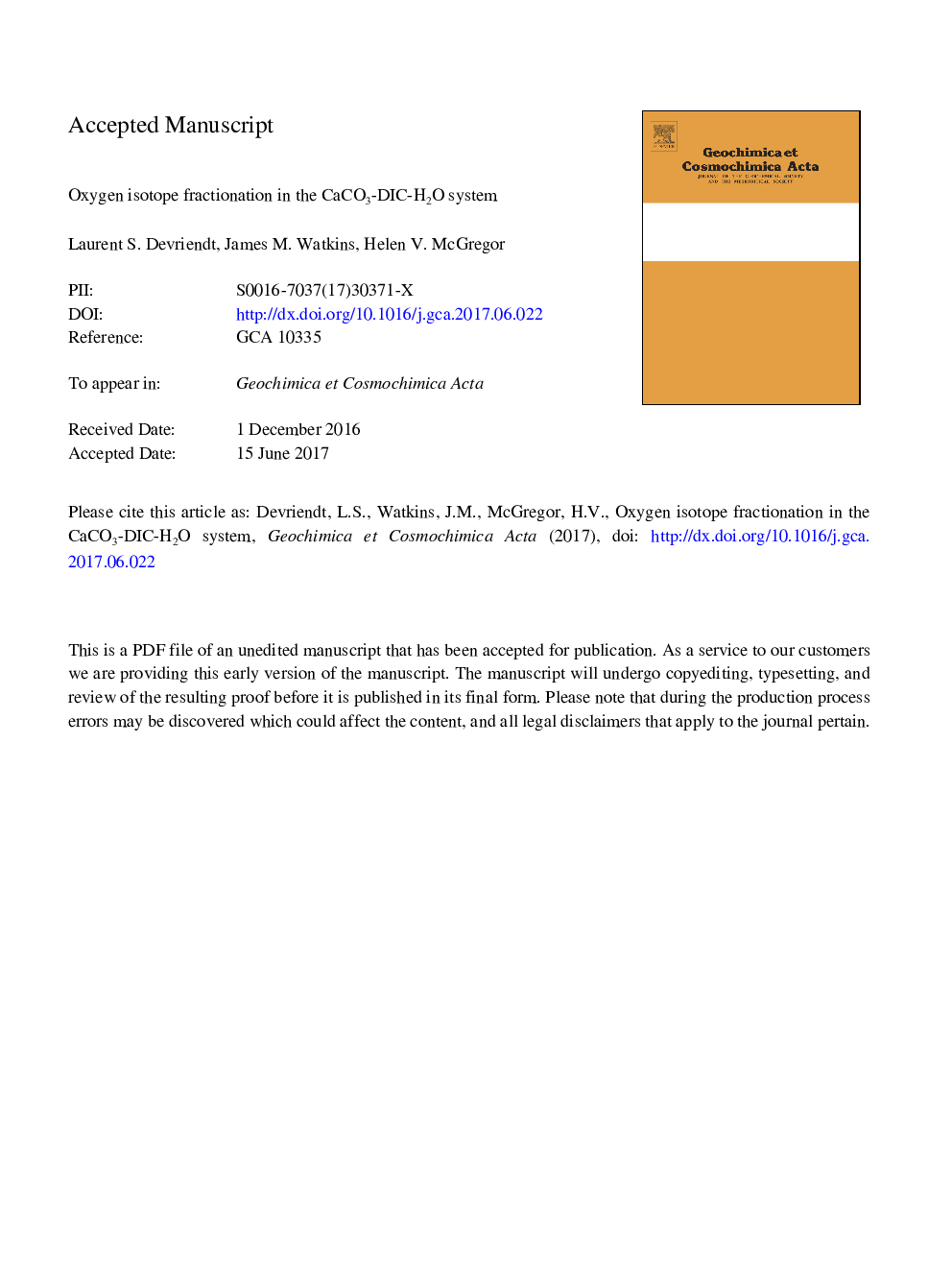| کد مقاله | کد نشریه | سال انتشار | مقاله انگلیسی | نسخه تمام متن |
|---|---|---|---|---|
| 5783138 | 1637943 | 2017 | 69 صفحه PDF | دانلود رایگان |
عنوان انگلیسی مقاله ISI
Oxygen isotope fractionation in the CaCO3-DIC-H2O system
دانلود مقاله + سفارش ترجمه
دانلود مقاله ISI انگلیسی
رایگان برای ایرانیان
کلمات کلیدی
موضوعات مرتبط
مهندسی و علوم پایه
علوم زمین و سیارات
ژئوشیمی و پترولوژی
پیش نمایش صفحه اول مقاله

چکیده انگلیسی
The oxygen isotope ratio (δ18O) of inorganic and biogenic carbonates is widely used to reconstruct past environments. However, the oxygen isotope exchange between CaCO3 and H2O rarely reaches equilibrium and kinetic isotope effects (KIE) commonly complicate paleoclimate reconstructions. We present a comprehensive model of kinetic and equilibrium oxygen isotope fractionation between CaCO3 and water (αc/w) that accounts for fractionation between both (a) CaCO3 and the CO32â pool (αc/CO32-), and (b) CO32â and water (αCO32-/w), as a function of temperature, pH, salinity, calcite saturation state (Ω), the residence time of the dissolved inorganic carbon (DIC) in solution, and the activity of the enzyme carbonic anhydrase. The model results suggest that: (1) The equilibrium αc/w is only approached in solutions with low Ω (i.e. close to 1) and low ionic strength such as in the cave system of Devils Hole, Nevada. (2) The sensitivity of αc/w to the solution pH and/or the mineral growth rate depends on the level of isotopic equilibration between the CO32â pool and water. When the CO32â pool approaches isotopic equilibrium with water, small negative pH and/or growth rate effects on αc/w of about 1-2â° occur where these parameters covary with Ω. In contrast, isotopic disequilibrium between CO32â and water leads to strong (>2â°) positive or negative pH and growth rate effects on αCO32-/w (and αc/w) due to the isotopic imprint of oxygen atoms derived from HCO3â, CO2, H2O and/or OHâ. (3) The temperature sensitivity of αc/w originates from the negative effect of temperature on αCO32-/w and is expected to deviate from the commonly accepted value (â0.22 ± 0.02â°/°C  between 0 and 30 °C; Kim and O'Neil, 1997) when the CO32â pool is not in isotopic equilibrium with water. (4) The model suggests that the δ18O of planktic and benthic foraminifers reflects a quantitative precipitation of DIC in isotopic equilibrium with a high-pH calcifying fluid, leading to a relatively constant foraminifer calcite δ18O-temperature relationship (â0.21 ± 0.01â°/°C). The lower average coral δ18O data relative to foraminifers and other calcifiers is best explained by the precipitation of internal DIC derived from hydrated CO2 in a high-pH calcifying fluid and minimal subsequent DIC-H2O isotopic equilibration. This leads to a reduced and variable coral aragonite δ18O-temperature relationship (â0.11 to â0.22â°/°C). Together, the model presented here reconciles observations of oxygen isotope fractionation over a range of CaCO3-DIC-H2O systems.
ناشر
Database: Elsevier - ScienceDirect (ساینس دایرکت)
Journal: Geochimica et Cosmochimica Acta - Volume 214, 1 October 2017, Pages 115-142
Journal: Geochimica et Cosmochimica Acta - Volume 214, 1 October 2017, Pages 115-142
نویسندگان
Laurent S. Devriendt, James M. Watkins, Helen V. McGregor,